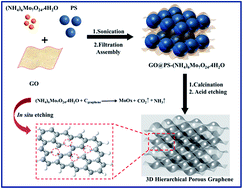In situ creating interconnected pores across 3D graphene architectures and their application as high performance electrodes for flow-through deionization capacitors†
Abstract
Three-dimensional graphene with hierarchical porous structure (3DHGR) was originally prepared as a high-performance electrode for flow-through deionization capacitors (FTDC). The 3DHGR was fabricated via combining a template-directed method and an in situ defect etching strategy. The as-obtained 3DHGR is composed of 3D graphene architecture with ample micro-/mesopores across the highly interconnected macroporous walls. The high specific surface area, hierarchical porous structure (micro-, meso- and macropores), high conductivity and good wettability of 3DHGR can ensure abundant adsorption sites and efficient electron and ion transport. In the electrochemical measurements, the 3DHGR exhibited higher capacitance and lower inner resistance. In the FTDC experiments, the 3DHGR showed a high salt adsorption capacity of 14.7 mg g−1 in a 500 ppm NaCl aqueous solution at 1.2 V. Moreover, the 3DHGR electrodes presented a faster salt adsorption rate in the applied voltage range of 0.8–1.2 V and in NaCl aqueous solutions at concentrations of 100–500 ppm. The 3DHGR electrodes also exhibited a good regeneration performance in the repeated electrosorption–desorption experiments. We hope that the 3D graphene with hierarchical porous structure and the 3D graphene building block can be extended to other electrochemical areas.


 Please wait while we load your content...
Please wait while we load your content...